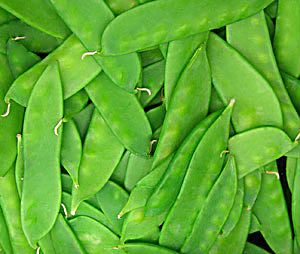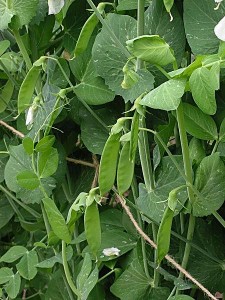 The Snow pea or Snap pea (Pisum sativum L), popularly known as “sitsaro” in the Philippines, is a legume, more specifically a variety of pea eaten whole in its pod while still unripe. It is one of the earliest-known cultivated plants. The pods of snow peas are flat and thin with the bulge of the tiny seed barely visible at prime eating stage. The bright green pods should be turgid and crisp. They contain five to seven seeds and reach a length of two to three inches. Snow peas provide vitamins A and C, iron and potassium. They are low in sodium. A 3 ounce serving, cooked and drained, contains 43 calories.
The Snow pea or Snap pea (Pisum sativum L), popularly known as “sitsaro” in the Philippines, is a legume, more specifically a variety of pea eaten whole in its pod while still unripe. It is one of the earliest-known cultivated plants. The pods of snow peas are flat and thin with the bulge of the tiny seed barely visible at prime eating stage. The bright green pods should be turgid and crisp. They contain five to seven seeds and reach a length of two to three inches. Snow peas provide vitamins A and C, iron and potassium. They are low in sodium. A 3 ounce serving, cooked and drained, contains 43 calories.
Snow pea is the most expensive vegetable legumes in the country. There are several types: garden peas, English peas, or green peas (P. sativum var. sativum); field peas or soup peas (P. sativum var. ravense); and flat, edible-podded snow peas also known as mange tout peas, sugar peas, or Chinese peas (P. sativum var. macrocarpon).
Garden peas are grown for their green peas, while field peas are grown for their dried seeds. The snow pea is the most common type grown in the Philippines. This group also includes the snap pea, a group of edible-podded peas that are differentiated from snow pea because of their round pods. Snap pea produces thick, full-bodied, edible pods, and sweet, full-sized peas. The pods snap when bent like fresh green beans. Snow pea generally has flat pods.
PRODUCTION MANAGEMENT:
Varieties
- Pole Type: Chinese Dark Green, Kalantao, Chinese 60, Sugar Snap, Melting Sugar, Trinidad, CGP 14, CGP 15, CGP 19, Sweet Pea DK30, Green Smile, Mini White
- Bush type: Dwarf Grey
The common varieties in the Philippines are flat-podded. The varieties listed are all flat-podded except for Sugar Snap. However, Sugar Snap is becoming popular in Bukidnon. This type is more succulent and crisp. They can be harvested for fresh pods even though the green immature seeds are already well-developed.
Soil and Climate Requirements
Sweet pea grows well in humus-rich or volcanic soil. It thrives best in areas at least 1,000 m above sea level. Sweet pea favors a cool climate with a temperature range of 10°- 18°C. In lower elevations, the plants are less vigorous and are more prone to diseases including powdery mildew. Moreover, their pods are more fibrous. A well-distributed rainfall is also important in growing this crop.
Planting Materials
Sweet pea is propagated from seeds. The recommended seeding rate is 40-50 kg/ha. Pre-soak the seeds for 12 hours in water prior to sowing to improve seed germination. In areas where sweet pea has not been grown before, treat the seeds with Rhizobium at 100 g per 6 kg of seeds to enhance nodulation for nitrogen fixation.
Land Preparation
Plow and harrow twice to make the soil more friable and weed-free. Make furrows 50-60 cm apart or plots 0.75-1 m wide for double-row planting.
Planting
Drill the seeds in shallow furrows at 5-10 seeds per linear meter. If hill planting is desired, place 2-3 seeds/hill at a distance of 20-30 cm between hills. The spacing between rows in double-row plots is 20 cm.
Weeding and Hilling Up
Control the weeds close to the plants to avoid competition. Usually, weeding three times is enough for the whole season. Low weed coverage along the alleys will help minimize leaf miner population. Hill up once, in time for the first sidedressing.
Fertilization
The general fertilizer recommendation is 126 kg/ha N, 44 kg/ha P2Os, and 125 kg/ha K20. Apply manure at 3-5 t/ha before planting to contribute 60 kg NPK and micronutrients. Apply 3 bags/ha 14-14-14 at planting. Split the balance of the NPK requirement and sidedress at 30 and 60 days after sowing. If necessary, apply lime at least 2 weeks before planting to gradually set the soil pH level to 6.0-6.5.
Trellising
Provide trellises to prevent the plants from lodging. Use bamboo, “rono” or wire # 16, or any available local materials. In Benguet, rono is used in a crisscross fashion in between the adjacent rows at 40-50 pcs/10 linear meters. Synthetic straw is also used to support the growing vines.
PEST AND DISEASE MANAGEMENT:
Pests and Recommendations
- Pea aphid – Spray hot pepper extract (100 g macerated hot pepper/16 L water), malathion, deltamethrin or other appropriate chemicals following the recommended rates.
- Pod borer – Handpick the larvae and pupae during the early stages of infestation. Spray with commercial preparations of Bacillus thuringiensis (Bt), Nuclear Polyhidrosis Virus (NPV), or hot pepper extract. If needed, spray with cypermethrin, fenvalerate, deltamethrin, or other appropriate chemicals following the recommended rates.
- Leaf miner – Encourage natural enemies like spiders, lacewings, and syrphid flies. If needed, spray with cyromazine or cartap hydrochloride following the recommended rates. Alternate different products of recommended pesticides to prevent development of insecticide resistance. Intercrop with leek, lettuce, pechay, and other shallow-rooted and short-season crops. Maintain low weed population along alleys.
- Slugs – Spread rice hull ash or slug pellets just enough to thinly cover the soil on the base of the plants.
Diseases and Recommendations
- Powdery mildew – Use resistant or tolerant varieties such as CGP 14. Apply protectant fungicides such as mancozeb or compost tea. Compost tea is prepared by soaking 1/2 sack (15 kg) of mature compost in a % drum (200-L capacity) of water for 5-7 days. Dilute the tea to 20 parts water and spray on the plants to prevent mildew infection.
- Ascochyta leaf spot – Practice field sanitation and crop rotation.
- Fusarium rot/ fusarium wilt – Prepare land properly. Use resistant or tolerant varieties such as CGP 14. Rotate planting with non-host crops such as crucifers and corn. Apply compost.

Harvesting
Harvest the crop at 60-65 days after planting. For best quality, sweet pea should be harvested before physiological maturity or before the peas deform the hull. Sweet pea should be harvested when the pods are of maximum size, but before any visible seed development. Frequent harvesting is necessary. Sugar snap pea should be harvested after they have developed seeds.
Harvest by priming twice a week. Harvesting can be extended up to 10 times for the entire growing period depending on crop management. Keep the produce under shade and pack in plastic crates. Sweet pea can be stored for 1-2 weeks at 0°C (32°F) with 95-98% relative humidity.
Seed Production
Select plants that are vigorous and are free of damage from pests and diseases. Harvest dry pods and extract the seeds. Dry pods can be harvested 120 days from sowing. Sun-dry to around 10% moisture content. To determine if the moisture content is acceptable, put some seeds inside a plastic bag and place under the sun. If condensation occurs after around 30 minutes, continue sun-drying the seeds.
Pack the dry seeds in moisture-proof containers and store in a cool, dry place. If properly stored, seeds can remain viable up to 2 years.
Source: PCCARD, DOST; Photos: wikipedia and realestatebloglab.com